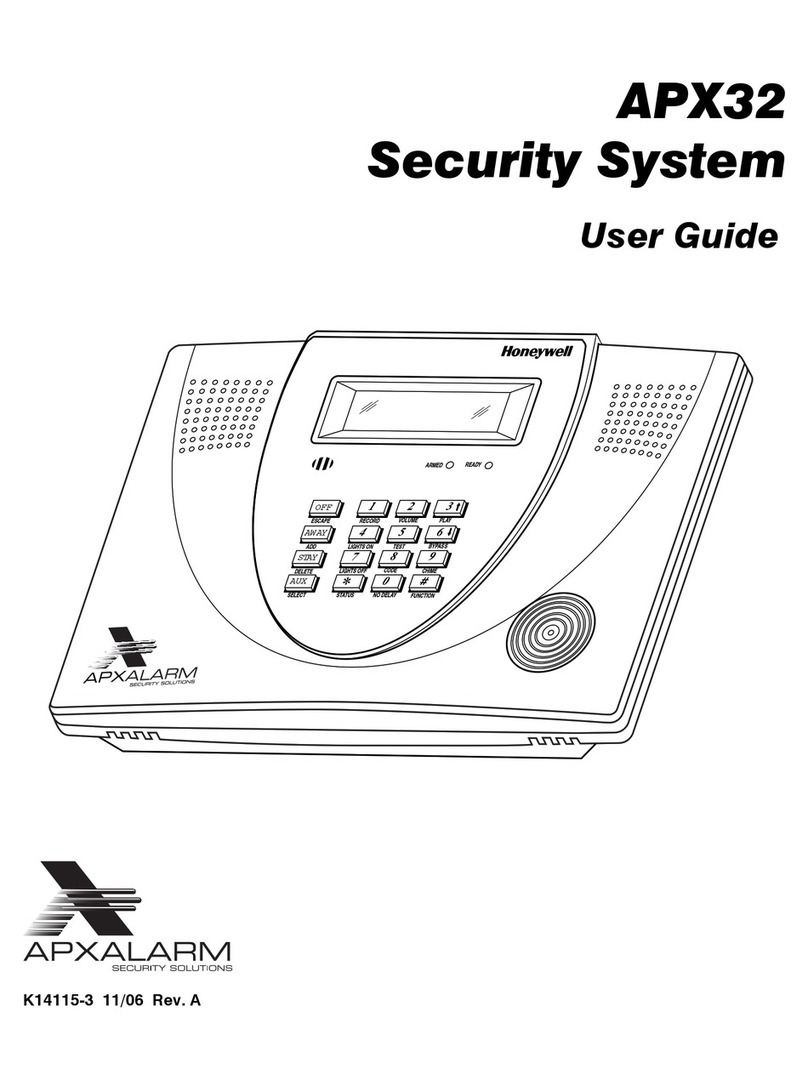
- 6 -
Field Function Programmed Values [ ] = Table 1 Default Value
✱49 SPLIT/DUAL REPORTING [0]
0 = Disable (None, unless primary fails)
TO PRIMARY PHONE No. TO SECONDARY PHONE No.
1 = Alarms, Restore, Cancel Others
2 = All except Open/Close, Test Open/Close, Test
3 = Alarms, Restore, Cancel All
4 = All except Open/Close, Test All
5 = All All
** Pager Message
A 7-digit code (plus optional 16-digit prefix) is
sent to the pager consisting of a 3-digit event code,
followed by 0 and a 3-digit user or zone number.
See Installation Instructions for an explanation of
the pager code, which takes the following form:
AAAAAAAAAAAAAAAA-EEE-0NNN
TO PRIMARY PHONE No.
6 = All except Open/Close
7 = All reports
8 = All reports
9 = All except Open/Close
TO PAGING** No. (Secondary)
Alarms, Open/Close‡, Troubles
Alarms, Troubles
Alarms, Open/Close‡, Troubles
Open/Close‡
‡Will report users 0, 5-8 or wireless
arm/disarm button zones 26-33; all other
zones and users do not report
AAA… = optional 16-digits (see field ✻88)
EEE = 3-digit event code: 911 (alarm), 101 (open), 102 (close),
811 (trouble)
0 = always displayed
NNN = 3-digit user number or zone number, depending on the
type of event (EEE) that occurred.
TO PRIMARY PHONE No.
10 = All except Open/Close
11 = All reports
12 = All reports
13 = All except Open/Close
TO SECONDARY (“FOLLOW
ME”) SYSTEM PHONE No.
Alarms, Open/Close‡, Troubles
Alarms, Troubles
Alarms, Open/Close‡, Troubles
Open/Close‡
‡Will report users 0, 5-8 or wireless
arm/disarm button zones 26-33; all other
zones and users do not report
✱50 15 SEC DIALER DELAY (BURG) †[0]
0 = no; 1 = yes; UL installations = 0
✱51 PERIODIC TEST REPORT †[0]
0 = none; 1 = 24 hours; 2 = weekly; 3 = 30 days
(enter Test Code in field ✻64)
✱52 FIRST TEST REPORT OFFSET †[2]
0 = 24 hour; 1 = 6 hours; 2 = 12 hours; 3 = 18 hours
(Time to 1st report from power up/programming or downloading).
✱53 SESCOA/RADIONICS SELECT [0]
0 = Radionics (0–9, B–F reporting); 1 = SESCOA (0–9 only reporting).
Select 0 for all other formats.
✱54 LACK OF USAGE NOTIFICATION [0]
0 = Disabled 4 = 90 days
1 = 1 day 5 = 180 days
2 = 7 days 6 = 365 days
3 = 27 days
✱55 REPORTING CHANNELS
[0]
0 = Telco Line (no Radio)
1 = LRR/IP(Digital Communication only) and Telco Line
3 = LRR/IP (Digital Communication only) (no Telco Line)
5 = LRR/IP (Digital Communication with AAV) (no Telco Line)
7 = LRR/IP (Digital Communication with AAV) and Telco Line
✱56 ENHANCED ZONE PROGRAMMING See procedure in this guide and refer to the Installation Guide.
✱58 RF JAM DETECT [0]
0 = no RF Jam Detection; 1 = RF Jam Detect on, no CS report;
2 = RF Jam Detect on with CS report
(if trouble/restore report is enabled in fields ✻60, ✻71)
Note: For event logging option 2 must be selected.
† Entering a number other than the one specified may give unpredictable results.






























